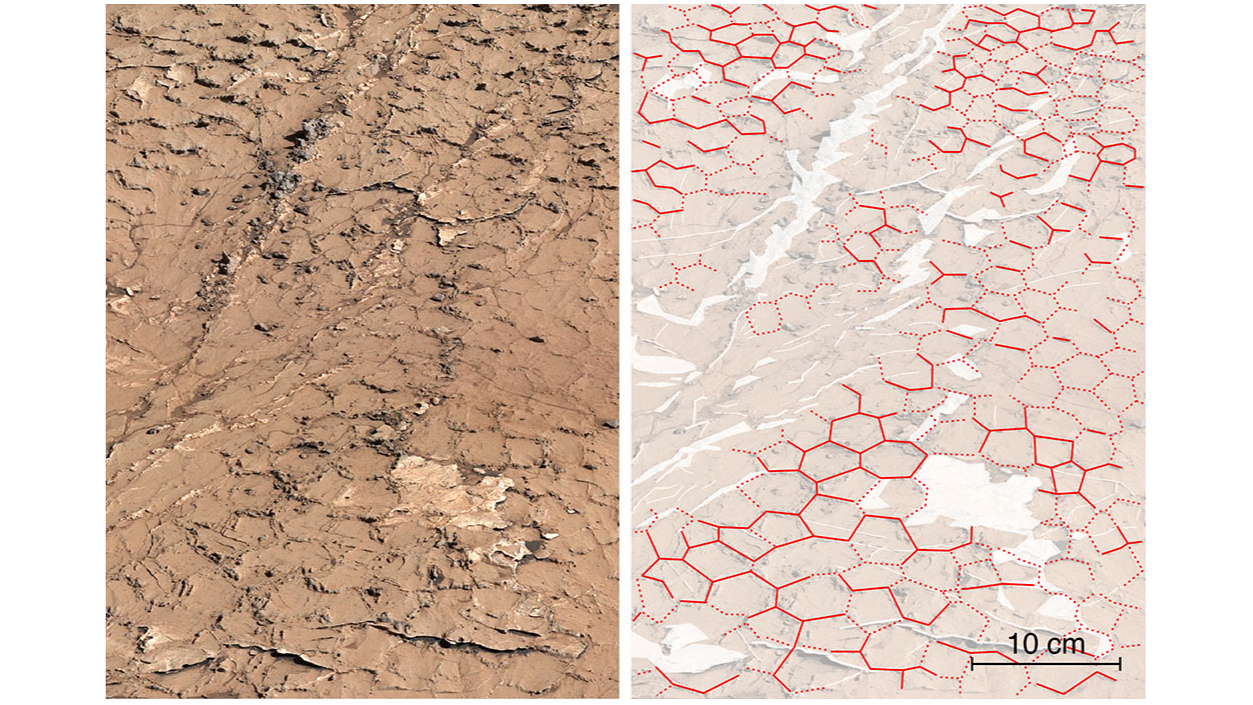Ancient mud cracks on Mars suggest Red Planet may have been more habitable than thought
'We now have for the first time vestiges of times that could have been conducive to the origin of life.'

Hexagon-tiled rock newly uncovered on Mars suggests that the Red Planet underwent a repeated cycle of wet and dry spells for up to millions of years that could have supported the emergence of life, a new study finds.
Although Mars is now cold and dry, researchers have for decades found evidence suggesting that the planet's surface was once covered with rivers, streams, ponds, lakes and perhaps even seas and oceans. Since there is life virtually everywhere on Earth where there is water, these ancient signs of water on the Red Planet raise the possibility that Mars was once home to life — and might host it still.
However, previous research suggested that dry spells may have also proven helpful to the evolution of life. Organic compounds that may have formed in water during wet times could have concentrated together in dry times, supporting chemical reactions that could have led to the emergence of life on Mars.
Related: Curiosity rover: 15 awe-inspiring photos of Mars (gallery)
"On Earth, people have run experiments that have shown that if you subject a rock to cycles of wet and dry spells, simple organic molecules can combine and form larger molecules, such as proteins, and even RNA," study lead author William Rapin, a research scientist at the French National Center for Scientific Research in Toulouse, France, told Space.com.
Now, using NASA's Curiosity rover, scientists have discovered signs that sites on early Mars underwent repeated cycling between wet and dry times. "We now have for the first time vestiges of times that could have been conducive to the origin of life," Rapin said.
In the new study, researchers focused on 3.6-billion-year-old rocks in Gale Crater, where Curiosity landed in August 2012. "We've seen mud cracks before, but the one at this location typically had T-shaped junctions," Rapin said. "This happens when the mud dried once and was fossilized in that state."
Get the Space.com Newsletter
Breaking space news, the latest updates on rocket launches, skywatching events and more!
In contrast, the scientists found mud cracks shaped like hexagons, which originated from Y-shaped junctions. "That was really exciting to us — it was an unexpected type of rock, something we hadn't seen on Mars before," Rapin said.
The researchers suggested these are fossilized cracks from ancient mud in a lakebed that regularly went through cycles of wet and dry times, possibly in a seasonal manner. "This formation had some depth, which tells us this cycling was sustained for a prolonged period, up to millions of years," Rapin said.
Previous research may not have detected such cracks because these are delicate features prone to erosion. "Here, they are exceptionally preserved," Rapin said.
Curiosity found sulfate salts at this formation. "Now we can look elsewhere on Mars at sites with these chemical traces from the same time to find signs of these climates and environments," Rapin said.
All in all, "so far, research has focused on the question of whether life arose on Mars, and now we can also look for traces of how might life have arisen on Mars," Rapin said.
The scientists detailed their findings online Wednesday (Aug. 9) in the journal Nature.
Join our Space Forums to keep talking space on the latest missions, night sky and more! And if you have a news tip, correction or comment, let us know at: community@space.com.

Charles Q. Choi is a contributing writer for Space.com and Live Science. He covers all things human origins and astronomy as well as physics, animals and general science topics. Charles has a Master of Arts degree from the University of Missouri-Columbia, School of Journalism and a Bachelor of Arts degree from the University of South Florida. Charles has visited every continent on Earth, drinking rancid yak butter tea in Lhasa, snorkeling with sea lions in the Galapagos and even climbing an iceberg in Antarctica. Visit him at http://www.sciwriter.us









